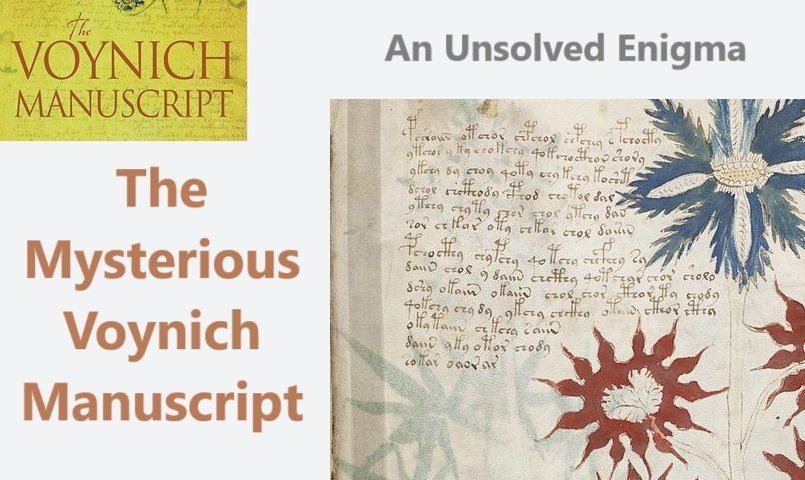
The Mysterious Voynich Manuscript: An Unsolved Enigma
Introduction
The Voynich Manuscript is one of the most enigmatic books in history, a document filled with an unknown script, bizarre illustrations, and mysterious diagrams. Discovered in 1912, this 15th-century codex has baffled cryptographers, historians, linguists, and scientists for over a century. Despite numerous attempts, its language, meaning, and purpose remain undeciphered.
In this detailed article, we will explore the origins, structure, possible interpretations, and ongoing mysteries surrounding the Voynich Manuscript.
Discovery and History
The manuscript is named after Wilfrid Voynich, a Polish book dealer who acquired it in 1912 from the Jesuit college at Villa Mondragone, Italy. Voynich attempted to decipher its text but failed, passing the mystery on to future generations.
Timeline of Ownership:
- 1404–1438: Estimated time of origin based on radiocarbon dating.
- 1600s: Likely owned by Emperor Rudolf II of the Holy Roman Empire, who may have believed it was the work of Roger Bacon.
- 1666: Owned by Johannes Marcus Marci, who sent it to Athanasius Kircher, a Jesuit scholar, hoping he could decode it.
- 1912: Rediscovered by Wilfrid Voynich.
- 1961: Sold to Hans P. Kraus, who later donated it to Yale University’s Beinecke Rare Book & Manuscript Library, where it remains today.
Physical Description
The Voynich Manuscript consists of 240 vellum pages, many adorned with strange illustrations and text written in an unknown script. It is approximately 23.5 cm tall, 16.2 cm wide, and 5 cm thick.
Content Breakdown:
The manuscript is divided into six distinct sections, based on the type of illustrations accompanying the text:
1. Botanical Section
- Largest section of the manuscript.
- Features detailed drawings of plants, most of which are unidentifiable.
- Some plants resemble known species, but others are entirely fictional.
2. Astronomical and Cosmological Section
- Contains circular diagrams, possibly representing zodiac signs, celestial bodies, or star charts.
- Some diagrams depict naked women interacting with cosmic symbols.
3. Biological Section
- Filled with drawings of nude female figures in strange, interconnected water channels.
- Theories suggest it could represent human anatomy, fertility, or alchemical processes.
4. Pharmaceutical Section
- Includes illustrations of containers, tubes, and medicinal plants.
- Some believe it is a medieval herbal guide.
5. Recipes Section
- Features pages of continuous text, possibly instructions or medical remedies.
6. Unknown Section
- Scattered throughout the manuscript, containing mystical symbols and indecipherable text.
The Mysterious Script
The Voynich Manuscript is written in an unknown language or cipher, commonly referred to as Voynichese. Despite numerous decryption attempts, the script remains undeciphered.
Characteristics of the Script:
- Composed of over 170,000 characters.
- Contains around 35,000 words.
- Appears to have repeating patterns and structured grammar, resembling a natural language.
- Lacks recognizable punctuation or syntax similarities to known languages.
Theories About the Script:
- Cipher Theory: It may be an encrypted text hiding secret knowledge.
- Linguistic Theory: Some scholars believe it could be an unknown or constructed language.
- Hoax Theory: Others speculate it is an elaborate medieval prank or fraud.
Attempts to Decipher the Manuscript
Since its discovery, linguists, cryptographers, and artificial intelligence researchers have tried to unlock the Voynich Manuscript’s secrets. Some major decryption attempts include:
1. Athanasius Kircher (1600s)
- Jesuit scholar attempted translation but failed.
2. William Friedman (1940s-1950s)
- A leading WWII cryptographer who worked on Nazi codes believed the text had a meaningful structure, but he never deciphered it.
3. AI & Machine Learning (21st Century)
- Computational linguists have applied machine learning algorithms, some suggesting links to Romance languages.
- A 2019 study claimed partial decoding, linking it to Hebrew, but it remains unverified.
Possible Explanations
Scholars have proposed several theories regarding the manuscript’s purpose:
1. Alchemical or Herbal Guide
- Some believe it is a medieval pharmaceutical text, describing herbs, astrology, and healing practices.
2. A Lost or Constructed Language
- It may represent a forgotten natural language or an artificial one.
3. Medieval Hoax
- Some argue it was created to deceive Emperor Rudolf II, who was known to collect esoteric manuscripts.
4. Extraterrestrial Origin
- A fringe theory suggests it could be a message from an alien civilization.
Conclusion
The Voynich Manuscript remains one of history’s greatest unsolved mysteries. Despite extensive research, we still do not know who wrote it, what language it is in, or what its purpose was.
As technology advances, future breakthroughs in AI, linguistics, and historical analysis may one day unlock its secrets. Until then, the Voynich Manuscript continues to fascinate and mystify scholars, cryptographers, and enthusiasts worldwide.
Would you like to take a stab at deciphering it? Let us know your thoughts on this intriguing historical puzzle!






